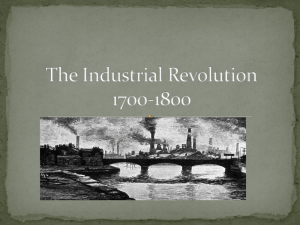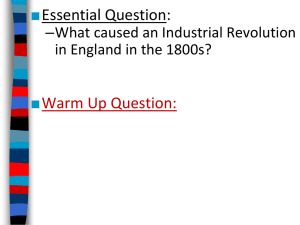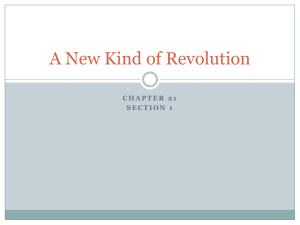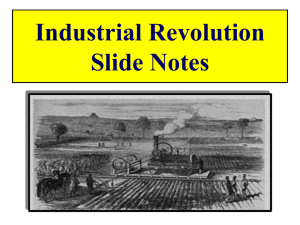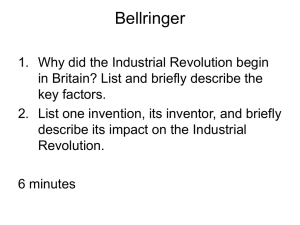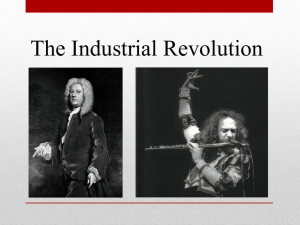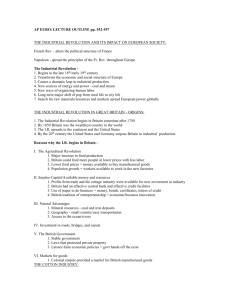File
advertisement
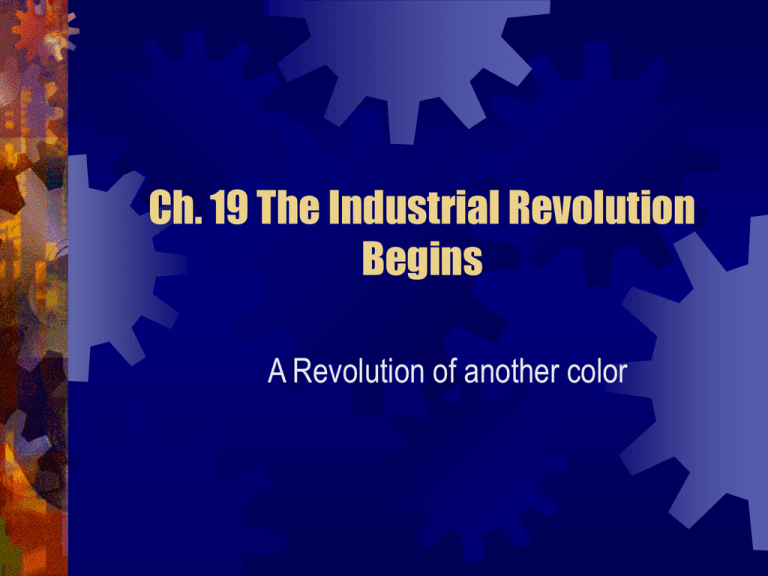
Ch. 19 The Industrial Revolution Begins A Revolution of another color Dawn of the Industrial Age • Started in Britain and was unlike most political revolutions because it was a long, slow, uneven process. • Production shifted from simple hand tools to complex machines. Manchester England 1890 Life Before and After T-chart! Before: A Rural way of life • • • • • Most People worked the land using handmade tools. Most people lived in simple cottages, in rural areas. Made their own clothes and grew their own food. They traded goods in nearby towns at outdoor markets. They knew little of the world that existed outside of their village. After: The City Life • Many country towns and villages have turned into cities and most people now live in cities. • Most people bought clothes and food that someone else produced. • Traveling was much more common and convenient thanks to the train and steam boat. Agriculture Spurs Industry • Improvements in farming led to a population boom. • Enclosures led to increase output (production of crops) but decrease in a the labor required to man the farms. • Enclosure- process of taking over and consolidating land formerly shared by peasant farmers, resulting in larger farms. • Because of enclosures farm workers left the rural areas in search of work and landed in cities where they could find jobs in factories. Technology Becomes Key • A key ingredient to the Industrial Revolution was a new efficient power source. • In 1712 the first coal powered steam engine was developed to help pump water out of mines. • In 1764 James Wyatt (a Scottish engineer) set out to make improvements to the first steam engine and after several years succeeded. • Wyatt’s engine became a key power source that fueled the Industrial Revolution. Quality of Iron Improves • In 1709 Abraham Darby used coal instead of charcoal to smelt Iron which resulted in a less expensive and higher quality iron. • Iron was needed to build steam engines and would be used more and more thanks to Darby’s method and production of better iron. 19.2 Britain Leads the Way Why Britain? Natural Resources Abound • Waterways and Ports (international access) made it easy to move resources and goods. • Coal was abundant • Vast Supplies of Iron • A less rigid society and social structure which allowed for my scientific thinking and inventing. • Available Work Force (population boom, out of work farmers due to Enclosures!) • Capitalists Capitalists • Beginning with the Slave Trade the business class accumulated Capital. The slave trade brought in investment capital. • Capital- Money used to invest in enterprises (a business organization such as shipping, mining or factories. • Capitalists were the “New Money” looked down upon by the upper class. • They took advantage of an opportunity to invest and make money, sometimes at the cost of others. Textile Industry • When Britian first began trying to organize a cotton cloth industry at home they developed the Putting-out System (aka cottage industry. • In this system cloth was produced in individual homes, raw cotton was handed out to peasant families who spun it into thread and then wove it into cloth in their own homes. • Under this method production was slow • The first factories developed in this industry. Inventions Improve Textiles • Richard Arkwright patents the Water Frame which is a spinning wheel that can be powered by water. • These inventions created a larger demand for raw cotton which presented a new problem. • How to process raw cotton faster. (Seeds had to be removed by hand). The Cotton Gin • Eli Whitney created the Cotton Gin which quickly separated the seeds from the cotton. • This GREATLY increased the availability of raw cotton. Transportation Improvements with a Price • Turnpikes – Private roads built by capitalists, a toll is charged for using it. • Canals – Artificial water ways created for transporting goods, often build along side a river/stream, or the existing river/stream is dug deeper. • Makes transporting goods much cheaper despite the fact that tolls are charged because these too are built by capitalists. Steam Engines Improve Transportation • Steam Boats – Water travel no longer relies on wind or currents and ships can move faster and across still bodies of water. • Steam Locomotive – These were not bound by rivers and could go across large expanses of land much quicker than by horse or foot. • The first major rail line opened in England in 1830 and ran between Manchester and Liverpool. 19.3 Social Impact of the Industrial Revolution New Social Classes Emerge • The Industrial Middle Class – Capitalists, those who set the revolution in motion by investing in inventions, technology and factories. • These people came from various backgrounds, merchants, skilled artisans and even some were “Rags to Riches”. • They lived well, had fancy clothes and material goods and most did NOT sympathize with the poor. Women and Children • Upper class (Nobles, Old Money)- Children were looked after by maidservants and women lived a life of luxury. • Middle Class (Capitalists, Bourgeoisie, New Money) – Woman did not work, but stayed home and focused on raising their children • Lower Class (working class)– Woman and children were part of the work force often working in factories or the children in mines. Industrial Working Class • Tenements – Multistory buildings where working class families lived packed into tiny rooms. • There was no running water or sewage or garbage disposal. • Waste and garbage rotted in the streets making these very foul smelling slums. Workers Stage Futile Protests • Labor Unions were illegal! • Some secret unions did exist. • Workers wanted change and improved conditions but had no power, which led to frustration and occasionally violence. • The first Industrial Riots occurred between 1811-1813. • Groups of textile workers known as the Luddites (a labor organization), smashed textile machines and burned factories. They usually operated at night and wore masks. Life working in a Factory • Shifts were 12-16 hours 6 or 7 days a week. • They could only take breaks when the factory owners gave permission. • Machines had no safety devices and accidents due to exhastion were frequent and resulted in the loss of fingers, limbs or even death. • Textile workers breathed in lint which damaged their lungs. • Injured and sick workers were fired with no compensation. • Factory workers were often women because employers could pay them less than men. Life working in a Mine • They were paid more than factory workers but the conditions were also much worse. • Coal dust destroyed their lungs, they worked in darkness and constantly faced the risk of flooding, explosions and collapsing tunnels. • Women and children worked in mines carrying heavy loads of coal on all fours in narrow passages and climbed ladders with heavy baskets of coal several times a day. Working Children • Some children starting working as young as FIVE years old! (usually closer to 7). • Their small size and nimble fingers were put to use changing spools in hot humid textile mills and repairing hard to reach machines. • In mines they sat all day in the dark opening and closing vents, or hauling coal. • Parents were used to the idea of their children working on the farm, and the wages the children earned were needed to keep the family from starving. Child Labor Reform • Child labor reform laws called the “factory acts” were passed in the early 1800s. • Reduced the workday of children to 12 hours • And kept children under the age of 8 or 9 from working in cotton mills. • The laws were generally not enforced until the 1830s-1840s. Results of the Industrail Revolution • People have debated since the 1800s whether the Industrial Revolution was a blessing or a curse. • The early days brought hardship but conditions gradually improved. • More jobs were created, and wages rose. • In the long run there was a general rise in the standard of living. • Pg. 621 Friedrich Engles 19.4 New Ways of Thinking Thomas Malthus • British Economist who like many other thinkers of his day tried to understand the rapid changes by looking for natural laws that applied to business and economics. • He discouraged vaccinations because he believed disease was a natural and necessary form of population control. Laissez-faire • In the early 1800s middle class business leaders embraced laissez-faire. • Adam Smith (The Wealth of Nations) the main proponent of laissez-faire, believed it would benefit all by reducing the cost of goods so everyone could afford them. • According to laissez-faire economists the cure for poverty was an unrestricted market. David Ricardo • An influential British Laissezfaire supporter who did not believe there was hope for the poor working class. • He wrote “Iron Laws of Wages” in which he said a wage increase would not increase the standard of living for the poor because they would just have more children. Jeremy Bentham • British philosopher and economist who advocated utilitarianism. • The idea behind utilitarianism is “the greatest happiness for the greatest number” • He believed all laws or actions should be judged based on if they provided more pleasure or pain? Socialism Develops Opposite Laissez-faire • Laissez-fair focused on individual rights while socialists focused on the good of society in general. • Under socialism the people as a whole rather than private individuals would own the means of production, which would solve poverty. • Grew out of the Enlightenment faith in progress and human nature and its concern for justice. Utopians • Early socialists who developed communities in which all work was shared and all property was owned in common. • Believed that when there was no difference between rich and poor all fighting would disappear. • The name Utopians implied they were impractical dreamers. Karl Marx • A German philosopher who in the 1840s formulated a new theory “scientific socialism”. • Teamed up with another German philosopher Friedrich Engles (whose father owned an English Textile factory) and wrote “The Communist Manifesto” • Published in 1848 • He theorized that economics where the driving force in History and that history was a series of class struggles. • The Haves (Bourgeoisie) Vs. the Have Nots (Proletariats) • He despised capitalism because he believed it created prosperity for a few and poverty for many. • Marx predicted that a struggle between social classes would result in a proletariat take over, and a classless (communist) society in which all means of production would be owned by the community would be formed. • He called for an international struggle to bring on the downfall of capitalism and he urged “Workers of the world, UNITE!”
